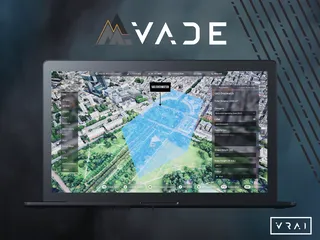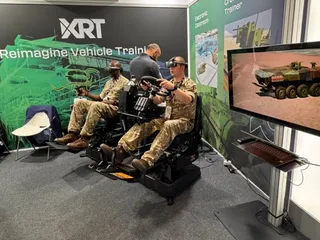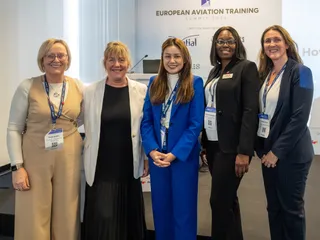Investing in Our Warfighters: The Imperative of Multi-Domain Readiness
Contact Our Team
For more information about how Halldale can add value to your marketing and promotional campaigns or to discuss event exhibitor and sponsorship opportunities, contact our team to find out more
The Americas -
holly.foster@halldale.com
Rest of World -
jeremy@halldale.com
.jpg/r%5Bwidth%5D=320/c6b73d60-2f1d-11f0-bc31-593a7fb0e5c5-clay-banks-kk3UKBAydXc-unsplash%20(1).webp)
Posted at the request and permission of NTSA
By VADM Sean Buck, USN (Ret.), President, National Training and Simulation Association
June 3rd will mark one year since I assumed the role of President of the National Training and Simulation Association. After more than four decades in uniform, I thought I had a solid grasp of the training and simulation enterprise—its breadth, its impact, and its people. I quickly came to realize there’s always more to learn.
Over the past year, I’ve been privileged to witness firsthand the extraordinary innovation and collaboration taking place across our community. From TSIS in Orlando to I/ITSEC—the world’s premier modeling and simulation event—and across the Atlantic to IT2EC in Norway, I’ve had the honor of engaging with the thought leaders, engineers, warfighters, and policymakers who are shaping the future of readiness.
What I’ve seen has reinforced a simple truth: we are standing at a pivotal moment. Technology is here. The demand for change is here. And our warfighters are ready. The question is—are we?
As we look ahead to an increasingly contested and complex security environment, one thing is clear: the nature of warfare has fundamentally changed. And with it, the way we prepare our force must change too. Multi-Domain Operations (MDO) are no longer an abstract concept. They are the operational reality—where land, sea, air, space, and cyberspace are engaged simultaneously and interdependently. This shift demands more than just adaptation; it demands transformation. We must train our warfighters not only to operate within their domain, but across all domains—with agility, precision, and speed. That requires integrated environments, immersive technologies, and the ability to make fast, informed decisions under pressure. We can’t afford to simply keep pace. We must lead.
MDO requires that we move beyond traditional joint operations. It’s about seamless, real-time coordination across every warfighting domain—executed at the speed of relevance. Our adversaries are watching closely. The margin for error is shrinking. To succeed, we must challenge ourselves to train as we intend to fight: connected, agile, and empowered by the full potential of emerging technology.
From Vision to Urgency
In 1978, USAF Capt. Jack Thorpe imagined a future where networked simulators could be used for mission planning and rehearsal. That vision, brought to life in the SIMNET project, laid the foundation for what we now know as Live, Virtual, and Constructive (LVC) training.
The need has never been greater. As digital environments evolve from two-dimensional simulations to fully immersive, three-dimensional operational spaces, our training ecosystem must evolve with them. This is not about replacing what works—it’s about scaling what matters and doing it in a way that meets the operational realities of today and tomorrow. It’s also about maximizing value for the American people. Every dollar we invest in simulation-based training is a dollar that yields not just greater readiness, but greater efficiency, reduced waste, and more prudent stewardship of taxpayer resources.
Training at the Point of Need
One challenge we face is cost and accessibility. High-end simulators are powerful but often tied to fixed locations. They simply can’t keep up with the demand for rapid, distributed training. That’s where extended reality comes in. The Air Force, recognizing the growing pilot shortfall, began leveraging the technology in 2018 to enhance throughput without compromising quality. With commercial airlines projecting a shortage of 30,000 pilots by 2025 and military pilot production under stress, we can’t afford to stick to the old playbook.
Virtual Reality (VR) and Mixed Reality (MR) offer new ways to train smarter. Whether it's a Sailor learning how to start a diesel engine in a submarine or a pilot rehearsing multi-domain engagement in an MR cockpit, these technologies provide realistic, hands-on experiences at the point of need—without the logistics burden.
These technologies are reshaping how we think about capability development in the Services and beyond. These tools aren't just futuristic concepts—they're delivering real-world savings and strategic advantages today. Take digital twins, for example. By creating dynamic, virtual models of our physical systems, we’re able to simulate, test, and refine designs without cutting a single piece of metal. That means fewer costly prototypes, faster development timelines, and a smarter path to fielding new Multidisciplinary Design Optimization (MDO) subsystems. It's about getting capability faster and more efficiently, without compromising on performance or readiness. In an era where speed and agility are paramount, these technologies are proving to be force multipliers—both operationally and financially.
The key advantage of modeling and simulation is the ability to deliver high-quality training at a fraction of the cost—no fuel, no risk, no bent metal. This enables far more repetitions than traditional methods, accelerating proficiency in realistic scenarios. Warfighters enter live platforms not to learn the basics, but to refine advanced skills—maximizing performance despite limited flight hours or field time. Simulators also allow for training in rare or combat-only scenarios, making M&S essential to building readiness while saving taxpayer dollars.
The AI Edge
Looking ahead, Artificial Intelligence—especially Generative AI (GenAI)—is poised to be a game-changer. AI can support mission planning, simulate realistic battlefield communications, adapt scenarios in real time, and drive personalized feedback through virtual tutors and after-action reviews.
Imagine a training environment that knows when a Marine is struggling with a task and dynamically adjusts the scenario to reinforce learning. Or one that captures the exact moment a decision was made and lets a team debrief it from every angle. This is no longer hypothetical—it’s happening, and it’s happening now.
When paired with M&S, AI makes the entire training cycle more adaptive, less labor-intensive, and far more cost-efficient—allowing commanders to do more with less while still meeting or exceeding mission standards.
Closing the Gap
This is not just about technology. It’s about leadership. It’s about embracing innovation across our defense industrial base, accelerating acquisition pathways, and removing barriers that slow down progress. If we’re serious about preparing for MDO, we need to be just as serious about investing in the systems, partnerships, and infrastructure that support it.
We are entering a new era of training—one defined by agility, powered by emerging tech, and centered on the warfighter. The moment to act is now.
At NTSA, we stand ready to work alongside the services, industry, government and our international partners to ensure that our training enterprise is not just reactive, but resilient and forward-leaning. Because in the world of MDO, you don’t get a second chance to be ready.
"Readiness is not just a responsibility—it's a sacred trust. We owe it to every Soldier, Sailor, Airman, Marine, Guardian and Coast Guardsman to prepare them for the complexity of tomorrow’s fight."


